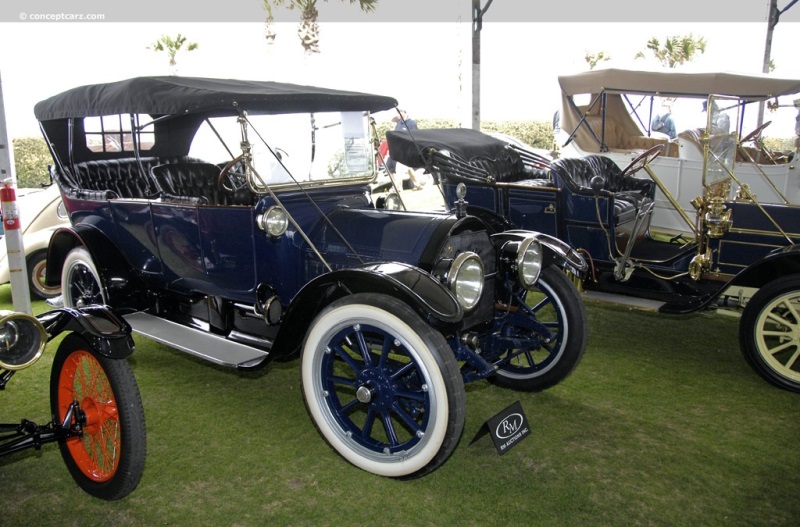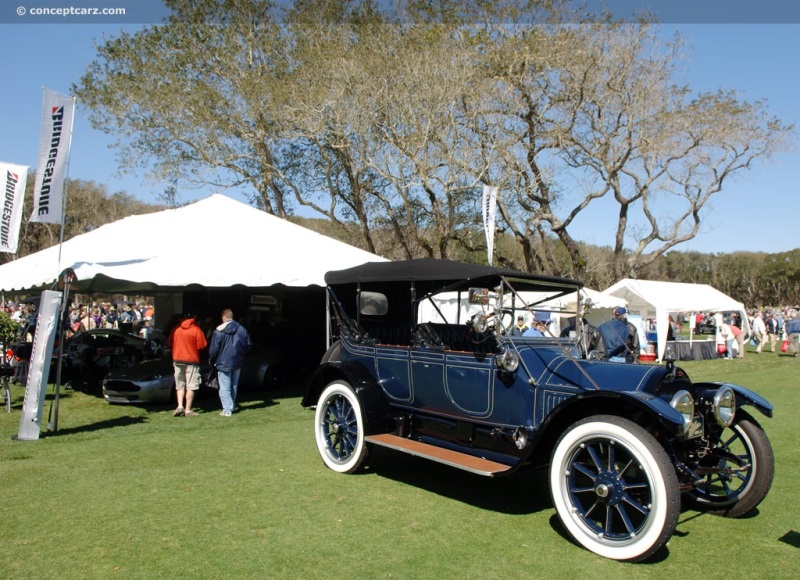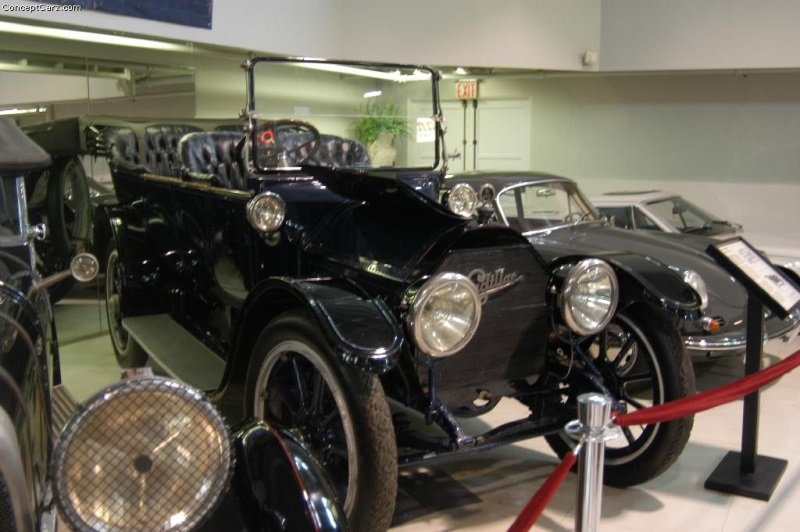The Cadillac Company was founded in 1903 by engineer Henry M. Leland of Leland & Faulconer Manufacturing Company from the remnants of the Henry Ford Company. Leland had been tasked with appraising the company's assets and preparing it for liquidation. Instead, Leland persuaded Ford's financial backers to continue manufacturing automobiles using the proven single-cylinder engine. The new Cadillac company, established on August 22nd of 1902, was named after French explorer Antoine Laumet de La Mothe, sieur de Cadillac, who had founded Detroit in 1701.
The early Cadillacs were two-seat horseless carriages powered by a single-cylinder engine offering 10 horsepower. A four-cylinder model joined the lineup in 1905. Cadillac's model lineup would include both one- and four-cylinder engines through 1909 when Cadillac simplified its lineup to a single four-cylinder model.
By 1908, Cadillac had won the prestigious Dewar Trophy after three of its cars were dismantled, the parts mixed up, and then reassembled and the cars run on the Brooklands track. The Model 'Thirty' was introduced in 1909 as the market for one-cylinder models had come to an end.
Cadillacs from 1903 through 1908 had wheelbase sizes that ranged from 72- to 102-inches. Cadillac offered a 76-, 82-, and 102-inch wheelbase through five different Models and fifteen body styles. For 1909, a single model, the Model 30, with three open body styles was offered on a 106-inch wheelbase chassis with a single dropped frame. The vertical, inline, L-head, four-cylinder engine had a 226.2 cubic-inch displacement, individual cast iron cylinder and copper water jacket, five main bearings, mechanical-pushrod-roller cam followers, a float feed carburetor made by Cadillac, and delivered 30 horsepower. It was backed by a three-speed selective, sliding gear transmission with a leather-faced cone clutch and right-hand drive with controls on the right. The transmission was mounted at three points to the frame cross members, and the universal joint was housed in a ball joint at the rear of the transmission. Stopping power was by mechanical brakes on two wheels, with the brake drum diameter growing to 12 inches mid-year. The rear axle with bevel gear differential was built by the American Ball Bearing Company. The cars rode on wood artillery 25-inch wheels with 10 and 12 spokes and quick detachable rims.
All three body styles had a factory base price of $1,400. The list included a three-passenger roadster, a two-door Demi-Tonneau, and a five-passenger tourer. The doors and cowls of the roadster and demi-tonneau were built from steel. All bodies had full running boards and running-board shields. The fenders were flat and there were no louvers in the hood.
The Model Thirty offered attractive styling and advanced engineering and would continue through 1914 with many changes along the way. The evolutionary 'electric self-start' and electrically operated lights, courtesy of the Delco electrical system, were introduced in 1912. Cadillac won the Dewar Trophy for the electric starter, and they adopted the slogan, 'Standard of the World' in the fall of 1912, in ads for the 1913 cars.
The 1913 Cadillac model line received more graceful, sweeping body lines and a lengthened 120-inch wheelbase. The remnants of the carriage era had ended as bodies now included a full cowl, flowing fenders, and fully enclosed driver controls. Mechanical advancements for 1913 included a longer stroke, a chain-driven camshaft, enclosed valve stems, and a simpler, more compact starter and generator.
Cadillac built 5,903 vehicles in 1909, and by 1913 the company would achieve a new sales record with 15,018 cars delivered.
1913 Cadillac body styles included a two-door coupe, a seven-passenger limousine, a roadster, and several four-door body styles including a phaeton, five- and six-passenger touring, and torpedo. The five-passenger touring, phaeton, roadster, and torpedo sold for $1,975, the six-passenger touring at $2,075, the limousine at $3,250, and the coupe at $2,500. The Phaeton was a new body style for 1913 and was the only one with trim molding running around the body.
The wheelbase now measured 120 inches and the bodies became smoother and the components became more integrated. All bodies had cowls except for the coupe. A top and windshield were now standard equipment, the sidelight wiring was now carefully concealed, and the front fenders had a reverse curve.
The 365.8 cubic-inch, L-head four-cylinder engine produced between forty to fifty horsepower. It had five main bearings, a float feed carburetor made by Cadillac to C.F. Johnson patents, an individual cast iron cylinder, and a copper water jacket. It continued to use a three-speed transmission, mechanical brakes on two wheels, and 10 and 12-spoke wood artillery wheels.
Optional equipment included a clock, weed chains, a handy lamp, a tire trunk, an electric horn, and an engine-driven tire pump. A running board trunk, seat covers, and front bumper were also optional.
by Daniel Vaughan | Dec 2020
The early Cadillacs were two-seat horseless carriages powered by a single-cylinder engine offering 10 horsepower. A four-cylinder model joined the lineup in 1905. Cadillac's model lineup would include both one- and four-cylinder engines through 1909 when Cadillac simplified its lineup to a single four-cylinder model.
By 1908, Cadillac had won the prestigious Dewar Trophy after three of its cars were dismantled, the parts mixed up, and then reassembled and the cars run on the Brooklands track. The Model 'Thirty' was introduced in 1909 as the market for one-cylinder models had come to an end.
Cadillacs from 1903 through 1908 had wheelbase sizes that ranged from 72- to 102-inches. Cadillac offered a 76-, 82-, and 102-inch wheelbase through five different Models and fifteen body styles. For 1909, a single model, the Model 30, with three open body styles was offered on a 106-inch wheelbase chassis with a single dropped frame. The vertical, inline, L-head, four-cylinder engine had a 226.2 cubic-inch displacement, individual cast iron cylinder and copper water jacket, five main bearings, mechanical-pushrod-roller cam followers, a float feed carburetor made by Cadillac, and delivered 30 horsepower. It was backed by a three-speed selective, sliding gear transmission with a leather-faced cone clutch and right-hand drive with controls on the right. The transmission was mounted at three points to the frame cross members, and the universal joint was housed in a ball joint at the rear of the transmission. Stopping power was by mechanical brakes on two wheels, with the brake drum diameter growing to 12 inches mid-year. The rear axle with bevel gear differential was built by the American Ball Bearing Company. The cars rode on wood artillery 25-inch wheels with 10 and 12 spokes and quick detachable rims.
All three body styles had a factory base price of $1,400. The list included a three-passenger roadster, a two-door Demi-Tonneau, and a five-passenger tourer. The doors and cowls of the roadster and demi-tonneau were built from steel. All bodies had full running boards and running-board shields. The fenders were flat and there were no louvers in the hood.
The Model Thirty offered attractive styling and advanced engineering and would continue through 1914 with many changes along the way. The evolutionary 'electric self-start' and electrically operated lights, courtesy of the Delco electrical system, were introduced in 1912. Cadillac won the Dewar Trophy for the electric starter, and they adopted the slogan, 'Standard of the World' in the fall of 1912, in ads for the 1913 cars.
The 1913 Cadillac model line received more graceful, sweeping body lines and a lengthened 120-inch wheelbase. The remnants of the carriage era had ended as bodies now included a full cowl, flowing fenders, and fully enclosed driver controls. Mechanical advancements for 1913 included a longer stroke, a chain-driven camshaft, enclosed valve stems, and a simpler, more compact starter and generator.
Cadillac built 5,903 vehicles in 1909, and by 1913 the company would achieve a new sales record with 15,018 cars delivered.
1913 Cadillac body styles included a two-door coupe, a seven-passenger limousine, a roadster, and several four-door body styles including a phaeton, five- and six-passenger touring, and torpedo. The five-passenger touring, phaeton, roadster, and torpedo sold for $1,975, the six-passenger touring at $2,075, the limousine at $3,250, and the coupe at $2,500. The Phaeton was a new body style for 1913 and was the only one with trim molding running around the body.
The wheelbase now measured 120 inches and the bodies became smoother and the components became more integrated. All bodies had cowls except for the coupe. A top and windshield were now standard equipment, the sidelight wiring was now carefully concealed, and the front fenders had a reverse curve.
The 365.8 cubic-inch, L-head four-cylinder engine produced between forty to fifty horsepower. It had five main bearings, a float feed carburetor made by Cadillac to C.F. Johnson patents, an individual cast iron cylinder, and a copper water jacket. It continued to use a three-speed transmission, mechanical brakes on two wheels, and 10 and 12-spoke wood artillery wheels.
Optional equipment included a clock, weed chains, a handy lamp, a tire trunk, an electric horn, and an engine-driven tire pump. A running board trunk, seat covers, and front bumper were also optional.
by Daniel Vaughan | Dec 2020
Related Reading : Cadillac Model 30 History
The Cadillac Model 30 was introduced in 1908 and remained in production until September of 1914. When first introduced, the Model Thirty sold for %241400 and available as a three-passenger Roadster, 2-door Demi-Tonneau with seating for four, or a two-door, five passenger Tourer. The wheelbase was 106-inches and powered by a 226.2 cubic-inch engine with five main bearings. There were three forward....
Continue Reading >>
Continue Reading >>
Related Reading : Cadillac Model 30 History
Cadillacs first vehicles were single-cylinder vehicles that offered reasonable power and durability. The single-cylinder engine would stay in production for six years. The third year of Cadillac production, a four-cylinder engine was introduced offering slightly more horsepower allowing for larger and heavier bodies to be fitted on the chassis. In 1905 the Model D featured seating for five and....
Continue Reading >>
Continue Reading >>
Similarly Priced Vehicles
Cadillac Monthly Sales Volume
March 2023
36,321
1913 Cadillac Model 30 Vehicle Profiles
Recent Vehicle Additions
Performance and Specification Comparison
Price Comparison
Model 30 Specification Comparison by Year
Year
Production
Wheelbase
Engine
Prices
Related Automotive News

Mercedes-Benz EQC 4Matic UK Pricing And Specification Announced
Prices start at £65,640 OTR for the EQC 400 4MATIC Sport Four trim lines available Sport, AMG Line, AMG Line Premium and AMG Line Premium Plus Two special editions available Edition 1 and Edition 1886 On sale...

Pricing And Specification For The New Mercedes-Benz GLE Revealed
Choice of two engines from launch GLE 300 d 4MATIC and GLE 450 4MATIC GLE 300 d 4MATIC, which replaces the GLE 250 d, is available from £55,685 OTR Prices start from £62,300 OTR for the GLE 450 4MATIC Order boo...

Born Confident? Order Your T-Roc Today!
T-Roc compact SUV enters new market segment for Volkswagen
Five-door T-Roc offers, space, style, safety and practicality
Selected versions open for order from 3 October, with prices starting at £20,425 RRP OTR
Milton Keynes – Volkswagen i...

American Classics, European Convertibles, and Cars of the Stars: SoCal Car Culture Comes to RM Sotheby's Santa Monica
RM Sothebys presents latest featured entries for its now single-day Santa Monica sale, 24 June at the historic Barker Hangar
Highlights include a highly original, California-bred 1929 Duesenberg Model J, a beautiful Light Green Poly 1960 Mercede...
MERCEDES-BENZ 2014 G63 AMG: THE ULTIMATE G-CLASS
The latest technology for the AMG off-road icon the new 2014 G63 AMG impresses with a state-of-the-art powertrain, expressive new design and improved efficiency. All this is largely attributable to the AMG 5.5-liter V8 biturbo engine delivering 536...































